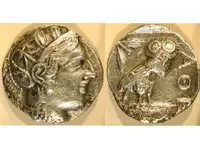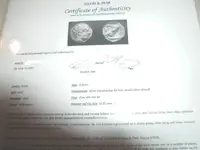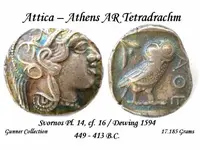- #1
Thread Owner
This is another recent acquisition of mine.? This is a "Fouree" or "Ancient Silver Plated Base Metal" Tetradrachm of Attica Athens (Greek).? This coin was struck sometime around 406 BC in Athens Greece.? Here is a write up on this issue.? The coin is currently being authenticated by David R. Sear.? It is 25mm in diameter and weighs 16.59 Grams.
The following is an excerpt taken directly from Doug Smith's Web Page:
"Toward the end (c. 406 BC) of the Peloponnesian War (with Sparta) , Athens found itself cut off from the silver mines at Laurion. Lacking enough silver to push forward the war effort the decision was made to issue a series of silver plated (fourree) copper coins that could be redeemed after the war for the regular, good silver product.
The technology for making silver plated coins was as old as coinage itself. Few people involved in coin production would not have known how to wrap a copper core in silver foil and bond the layers with heat and the force of striking. Whether this coin was produced in the mint, on the "sly" by mint workers or by counterfeiters is similarly unclear.
The wide acceptance of these coins led the mint to be slow in updating the style of the artwork on the coins. The portrait of Athena continued to use the Archaic style "almond" eye long after popular art style had passed into the Classical period. Care was taken not to do anything to hurt the acceptance of the coins. What was good money for the Athens of old still seemed good a century later."
http://64.233.161.104/search?q=cach...fo/feac36owl.html+Athens+Owl+Doug+Smith&hl=en
Gunner
The following is an excerpt taken directly from Doug Smith's Web Page:
"Toward the end (c. 406 BC) of the Peloponnesian War (with Sparta) , Athens found itself cut off from the silver mines at Laurion. Lacking enough silver to push forward the war effort the decision was made to issue a series of silver plated (fourree) copper coins that could be redeemed after the war for the regular, good silver product.
The technology for making silver plated coins was as old as coinage itself. Few people involved in coin production would not have known how to wrap a copper core in silver foil and bond the layers with heat and the force of striking. Whether this coin was produced in the mint, on the "sly" by mint workers or by counterfeiters is similarly unclear.
The wide acceptance of these coins led the mint to be slow in updating the style of the artwork on the coins. The portrait of Athena continued to use the Archaic style "almond" eye long after popular art style had passed into the Classical period. Care was taken not to do anything to hurt the acceptance of the coins. What was good money for the Athens of old still seemed good a century later."
http://64.233.161.104/search?q=cach...fo/feac36owl.html+Athens+Owl+Doug+Smith&hl=en
Gunner




 WOW! Now that's what I call a find!?
WOW! Now that's what I call a find!? 



